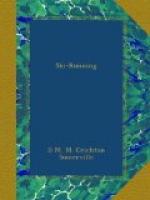We followed the lantern and saw it stop and knew the Guides had reached the people in trouble. When we caught up they already had the patient looking like a mummy, rolled up in blankets in a canvas bag on the sledge. I could hear him choking over the brandy which was being poured down his throat. He had only hurt his knee, but his friends, who were all real novices, had had a wearing time getting him down.
The way in which the Guides handled the job filled me with admiration and confidence. When they found we were ready to herd the party home, they shot off with their sledge and the lantern soon became a speck of light in the distance again.
I also had a lantern that night, and found it delightful to ski by, but doubt whether anyone else profited much by its light except as a guide to direction.
When a person is hurt and helpless at a high level, in winter, cold is the most immediate danger, and all spare clothing should be piled on him, and his limbs should be rubbed to prevent frost-bite. When he cannot be moved, a fire might well be lit if below tree level where wood is available, because, though the lighting of fires is forbidden in the Swiss forests, a breach of the law would surely be overlooked in case of danger to life. The heat of the fire would help to keep the patient warm, while its light would act as a beacon to the search party.
The following is the code of signals in use among the Alps:
The Alpine Signal of Distress—
(a) By Day.—The waving of anything (a flag or stick with an article of clothing attached) six times in a minute, repeated after an interval of one minute without signals.
(b) By Night.—A light flashed six times a minute, repeated after an interval of one minute without signals.
(c) By Sound.—Six sharp calls, or whistles, in the minute, repeated after an interval of one minute without signals.
The Answering Call—
(d) Anything waved, a light flashed, a sharp call, or whistle three times in the minute, repeated after an interval of one minute without signals.
If a Ski runner does not remember the exact signal any regular signal repeated a definite number of times in a minute, with a minute’s interval, should prove sufficient. Similarly, if you hear a signal repeated at short regular intervals, you should always suspect a call for help.
An ordinary whistle is hardly loud enough for the sound to carry any distance and a siren might be better. Newspaper could be used for a flare if the party does not possess a lantern or electric torch, but it would not last long.
Finally, may I suggest that everyone who takes up Ski-ing seriously, and who carries gear to be used in emergency, should be proficient in the use of such gear and not wait till it is needed to find out how to fit it.
To experiment in making an ambulance sledge while an injured person lies beside you and when your fingers are cold and people are buzzing round you with suggestions, which may or may not be better than your own ideas, is a bad plan. It is wiser to have made the experiment at home and to have got someone to drag you down a hill on the result, and then you will know something about it. A new game for the Nursery slopes, and what fun for the spectators who already think all Skiers mad!




